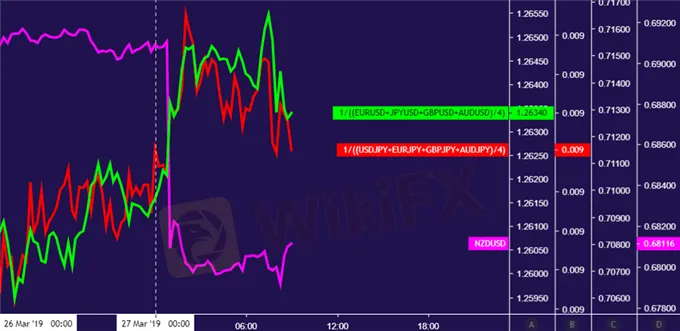简体中文
繁體中文
English
Pусский
日本語
ภาษาไทย
Tiếng Việt
Bahasa Indonesia
Español
हिन्दी
Filippiiniläinen
Français
Deutsch
Português
Türkçe
한국어
العربية
Brexit Votes May Distract From Global Slowdown Worries
Abstract:Financial markets may be distracted from worries about a slowdown in global economic growth as traders eye another round of votes shaping the trajectory of Brexit.
TALKING POINTS – YEN, US DOLLAR, NEW ZEALAND DOLLAR, BREXIT
Yen, US Dollar rise as dovish RBNZ stokes global growth fears
ECBs Draghi may amplify worries with downbeat commentary
Brexit votes may delay conviction on sentiment-driven volatility
The anti-risk Japanese Yen and US Dollar rose after the RBNZ became the latest in a series of major central banks to warn about a darkening outlook for global economic growth. The New Zealand Dollar was understandably hurt by dovish commentary from its local monetary authority, but the sentiment-linked Australian Dollar also weakened, likely reflecting broader risk-off flows.
Looking ahead, scheduled commentary from ECB President Mario Draghi may add to slowdown worries. A downbeat disposition was already on display at this month‘s policy announcement, so more of the same would not be a stretch. Capacity for follow-through will probably be determined by the degree to which Mr Draghi’s remarks dial up the sense of urgency.
With that in mind, directional conviction on any broad sentiment-directed will probably have to wait for the outcome of a series of “indicative votes” on the future path for Brexit. MPs are attempting to wrestle control of the process from Prime Minister Theresa May and will voice their preference for a variety of competing options for EU withdrawal terms and perhaps even consider a second referendum.
What are we trading? See the DailyFX teams top trade ideas for 2019 and find out!
CHART OF THE DAY – DOVISH RBNZ SPARKS DEMAND FOR ANTI-RISK CURRENCIES

The chart above tracks the intraday reaction to the dovish RBNZ monetary policy announcement. The sharp drop in the Kiwi Dollar play out inversely of a rise in the average value of the US Dollar and Yen against their major currency counterparts. Tellingly, the averages do not include the NZD, implying that these moves reflected broader haven-seeking capital flows.
Disclaimer:
The views in this article only represent the author's personal views, and do not constitute investment advice on this platform. This platform does not guarantee the accuracy, completeness and timeliness of the information in the article, and will not be liable for any loss caused by the use of or reliance on the information in the article.
WikiFX Broker
Latest News
ASIC Sues Binance Australia Derivatives for Misclassifying Retail Clients
AIMS Broker Review
The Hidden Checklist: Five Unconventional Steps to Vet Your Broker
WikiFX Review: Is FxPro Reliable?
Malaysian-Thai Fraud Syndicate Dismantled, Millions in Losses Reported
Trading frauds topped the list of scams in India- Report Reveals
YAMARKETS' Jingle Bells Christmas Offer!
Doo Financial Expands Regulatory Reach with Offshore Licenses in BVI and Cayman Islands
Why is there so much exposure against PrimeX Capital?
Russia to Fully Ban Crypto Mining in 10 Regions Starting January 1, 2025
Currency Calculator


